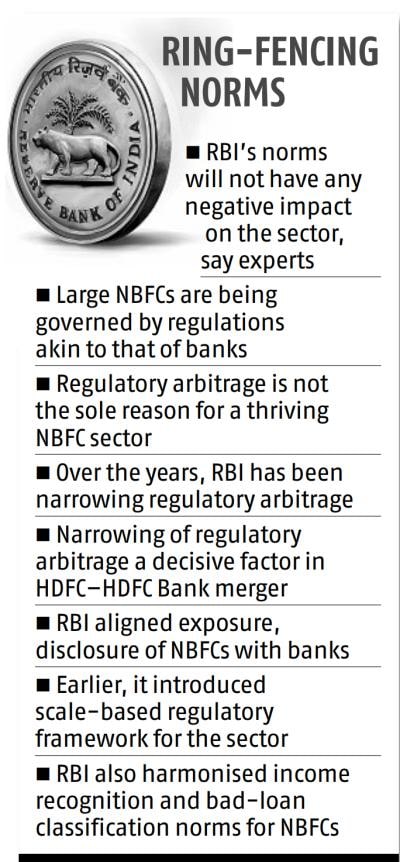Reserve Bank of India’s latest norms won’t be disruptive to NBFCs
The latest norms concerning large exposures, additional disclosures, and lending to directors laid down by the Reserve Bank of India (RBI) for non-banking financial companies (NBFCs) are in line with its stated objective of narrowing the regulatory arbitrage between banks and shadow banks, observed industry insiders, adding it would be broadly non-disruptive in nature for the sector.
On Tuesday, the central bank mandated exposure limits for NBFCs in the upper layer, in line with commercial banks, by capping their aggregate exposure towards one entity at 20 per cent of capital base, extendable by another 5 per cent with board approval.
For a particular borrower group, the cap is at 25 per cent, with additional 10 per cent if exposure is towards infrastructure. These norms will have a bearing on only a few NBFCs in the sector because most of them are into retail and micro, small, and medium enterprise (MSME) lending, said experts.
Krishnan Sitaraman, senior director and deputy chief ratings officer, CRISIL, said, “We are not expecting any material impact because of this for most NBFCs as their focus is on the retail and/or MSME segments. These are segments where a large exposure limit is not expected to be frequently triggered as they would typically not be taking large exposures to a single counterparty.”

“The framework will be relevant to NBFCs that are into lending to the corporate or wholesale segment, but their numbers are few. Even for them, single counterparty exposure will not be very different from what existed earlier, but the group exposure limit has been brought down to 25 per cent, from 40 per cent. In the past two/three years, many NBFCs have raised capital and increased their net worth and tier 1 capital which in the context of muted growth has meant that leverage levels have come down.” he added.
In separate circulars, the RBI asked NBFCs to report details of their divergence in asset classification and provisioning requirements in their annual financial statements, if the divergence breaches the threshold set by the central bank. It has also asked them to make several other additional disclosures in their notes to accounts, such as their exposure to the real estate sector, capital markets, intra-group entities, and unhedged foreign currency exposure.
Further, it said, for lending to the real estate sector, NBFCs have to ensure borrowers have prior approval from the government or local authorities for the project for availing of loans. Norms have also been tightened for lending to board members and their relatives by NBFCs in the middle and upper layer.
Umesh Revankar, vice-chairman and managing director, Shriram Transport Finance Company, said, “I don’t think there will be any negative impact on NBFCs because of the norms brought in by the RBI. Large NBFCs are already subject to similar regulations as banks. Some additional requirements are not going to have a negative impact.”
Over the years, the RBI has been harmonising regulations between NBFCs and banks in the wake of defaults seen in the shadow banking space, which started with the Infrastructure Leasing & Financial Services going bust.
“I don’t agree with the view that NBFCs have thrived because there was regulatory arbitrage. The markets are different for banks and NBFCs. There are certain customer segments that banks do not lend to because of lack of reach and understanding. As long as there is a vacuum in these market segments, NBFCs will thrive. NBFCs are not a competitor to banks. Rather they complement banks in reaching credit-starved segments and geographies, where banks find it unviable,” said Revankar.
The RBI came out with scale-based regulations for the NBFC sector last year in October, wherein it ensured that large NBFCs will be subject to greater scrutiny — akin to that of banks. Further, the RBI harmonised the income recognition and non-performing asset classification norms for NBFCs, which was seen as another step by the central bank to bring the regulations of NBFCs on a par with banks. They also introduced a liquidity coverage ratio for NBFCs. Recently, they asked NBFCs in the upper and middle layer to implement a core financial services solution — a system analogous to the core banking solution used by banks.
The narrowing of regulatory arbitrage between banks and NBFCs proved to be a decisive factor in the merger of mortgage financier HDFC with HDFC Bank. Experts have said that with the RBI killing the arbitrage in norms between banks and NBFCs, it will be increasingly difficult for NBFCs to operate and maintain the same levels of profitability.
“While the RBI has harmonised regulations of large NBFCs with that of banks, what about a similar harmonisation of benefits in tax and recovery-related matters where NBFCs face a distinct bias. It is imperative the RBI talk to the Ministry of Finance and ensure the same. Why should NBFCs be made to knock at the door of North Block for this? Unless this is taken care of, this process of ‘harmonisation’ will remain piecemeal,” said Raman Aggarwal, area chair, Council for International Economic Understanding.